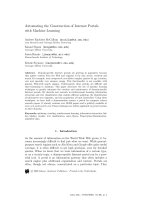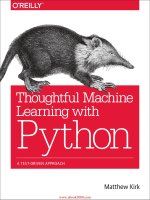Wifi fingerprinting-based indoor positioning with machine learning algorithms
Bạn đang xem bản rút gọn của tài liệu. Xem và tải ngay bản đầy đủ của tài liệu tại đây (437.81 KB, 5 trang )
WiFi Fingerprinting-based Indoor Positioning with
Machine Learning Algorithms
Luong Nguyen Thi
Faculty of Information Technology
Dalat University
Dalat, Vietnam
Ninh Duong-Bao
College of Computer Science and Electronic Engineering
Hunan University
Changsha, China
Huy Quang Pham
Faculty of Mathematics and Informatics
Dalat University
Dalat, Vietnam
line 4: City, Country
Abstract—With the rapid advances of mobile devices,
location-based services have received significant attention.
Among the available services, finding the exact position of a
person, especially indoors, is a challenging problem. For indoor
environments, using WiFi-based technology for positioning
purposes is reasonable due to its utilization of existing WiFi
infrastructure. In this paper, we implement and compare the
positioning results of three machine learning algorithms such as
support vector machine, decision tree, and random forest. The
algorithms are applied to a multi-condition WiFi fingerprinting
dataset which was conducted in an office room where different
environmental conditions are considered. The results show that
the random forest achieves the best classification result with an
accuracy of over 85%, while the two others get an approximate
accuracy of 80%.
Khanh Nguyen-Huu
Department of Electronics and Telecommunications
Dalat University
Dalat, Vietnam
Keywords—WiFi fingerprinting, indoor positioning, machine
learning, support vector machine, decision tree, random forest
Fig. 1. RSS values collection.
I. INTRODUCTION
online positioning phase. In the former phase, the RSS values
are collected from available APs at different predefined
reference points (RPs) in a setup area to make the fingerprints
(i.e. sets of RSS values) for every RPs as shown in Fig 1. The
fingerprint and the location of each RP together create the
fingerprinting database (radio map). In the latter phase, the
measured RSS values collected at an unknown position are
compared and matched with the fingerprint of each RP in the
database to find out the closest match, then the user’s position
is determined. Besides its utilization of WiFi infrastructure,
the WiFi fingerprinting technique has another advantage as it
does not require the line-of-sight condition from the APs, thus,
it can be applied in complex environments where exist many
obstacles such as the walls, doors, furniture, etc.
Nowadays, the Global Positioning System (GPS) has
become a reliable and indispensable service to localize a
person using a mobile device in outdoor environments.
However, it is not true in indoor areas such as buildings since
the satellite signals are blocked by walls or ceilings, thus, these
signals are very weak indoors and cannot guarantee the same
positioning accuracy as outdoors. For that reason, there
requires the development of indoor positioning systems (IPS)
to track the user’s position indoors.
Currently, many technologies can be used for indoor
positioning such as radio frequency identification (RFID) [1],
Bluetooth [2], visible light communication (VLC) [3], vision
[4], inertial sensors [5], etc. Due to the widespread of WiFi
Access Points (APs) in indoor environments, there exist a lot
of WiFi-based positioning systems that use the Received
Signal Strength (RSS) values collected from the deployed APs
to determine the user’s position. The major challenge of these
WiFi-based systems is the instability of the RSS values due to
the effects of shadowing, multipath, or even the changes in
surrounding environments such as the room temperature, the
number of electrical devices, the number of working people,
etc.
Generally, the matching algorithms in the online phase of
the WiFi fingerprinting technique can be classified into two
approaches: deterministic and probabilistic. RADAR [6] and
Horus [7] were the very first systems that used the
fingerprinting idea for indoor positioning. The first system
used the K-nearest neighbors (KNN) which is one of the most
popular algorithms of the deterministic approach. Meanwhile,
the second system was based on the probabilistic approach
which analyzed the statistical characteristics as well as the
distribution of RSS values. More recently, following the
deterministic approach, Ninh et al. [8] proposed a random
statistical algorithm that firstly standardized the radio map in
the offline phase, then applied the Mahalanobis distance to get
WiFi fingerprinting is one of the most popular and
promising techniques for indoor positioning. This technique
basically contains two phases: an offline training phase and an
67
Fig. 2. System architecture.
the user’s position instead of using the Euclidean distance
which often works in the NN-based algorithms. Comparing
the five different distance measures, Duong-Bao et al. [9]
demonstrated that the basic Euclidean distance can be
replaced by other distance measures to increase the
positioning accuracy. The results revealed that the ChiSquared distance was the best measure. Even when the authors
changed the RSS collection settings in the offline phase such
as changing the distance between two adjacent RPs or
changing the number of available APs, the Chi-squared
distance still kept its best results compared to other measures.
Currently, the probabilistic approach also receives attention
with different methods applied to solve the indoor positioning
challenge. Kalman filter [10], particle filter [11], and hidden
Markov models [12] are some famous algorithms used in this
approach. To increase the positioning accuracy, Zhuang et al.
[13] combined the tracking information from the inertial
sensors as well as the WiFi fingerprinting using two Kalman
filters. Moreover, with the same idea of combining different
positional information from different algorithms such as WiFi
fingerprinting, pedestrian dead reckoning, and some points of
interest in indoor environments using an extended Kalman
filter, Deng et al. [14] reduced the positioning error to under
1.5 m, which was a very promising result.
and RF positioning results and concluded that SVM using the
linear kernel surpassed the others with a 2-meter positioning
error.
In this paper, we implement and compare the performance
of three machine learning algorithms like SVM, DT, and RF.
To evaluate the performance of each algorithm, we applied
them to a free-accessed database that considered different
environmental conditions when they collected the RSS values
such as the number of electrical devices, the number of people,
the period in a day, and the user’s orientation, etc. We aim to
analyze the classification accuracies of the aforementioned
algorithms in a complicated indoor environment.
The remainder of the paper is organized as follows:
Section 2 gives the material and methods. The experimental
results are analyzed and discussed in Section 3. Finally,
Section 4 concludes the paper.
II. MATERIAL AND METHODS
A. System Overview
Fig. 2 presents the system architecture of the WiFi
fingerprinting with the machine learning classifiers. The
system consists of two phases: an offline training phase and
an online prediction phase. During the offline phase, the sets
of RSS values are collected at different pre-defined RPs to
create the fingerprinting database. Then, the training set and
testing set are divided from the established database with a
ratio of 9:1. The RSS values collected from available APs are
used as the input features with the label is one RP position.
Then, the RSS values will be put into the classifier for training.
In the online prediction phase, the testing set is classified by
applying different matching algorithms (i.e. the machine
learning algorithms) to find out the user’s position as one
candidate among the whole RPs’ positions.
Over the past few years, machine learning algorithms have
gained popularity in different aspects of our daily modern life,
thus, these algorithms are also applied to indoor positioning to
improve the positioning accuracy and enhance the robustness
of the IPSs. To deal with the variation of the RSS values,
which directly affects the performance of the WiFi
fingerprinting, Rezgui et al. [15] introduced a room-level
positioning algorithm based on the support vector machine
(SVM). From the experimental result, it was shown that the
proposed algorithms achieved an accuracy of 98.75%.
Bozkurt et al. [16] implemented and compared seven different
machine learning algorithms such as KNN, decision tree (DT),
Naïve Bayes, Adaboost, etc. The authors figured out that
among the algorithms, KNN was the best one for solving
classification problems with an accuracy of 99.7% for
building and 98.5% for floor classifications, respectively. In
[17], Gomes et al. proposed a hybrid random forest (RF)
model to handle the fluctuations of the RSS values. From the
experiments with seven setup APs, the high accuracy of
98.3% was reached using the K-fold cross-validation of 3.
Meanwhile, in [18], Salamah et al. compared the SVM, DT,
B. Classification Algorithms
The three classification algorithms used in this paper are
all supervised learning algorithms and each one is introduced
as follows.
•
68
Support vector machine (SVM) is one of the efficient
machine learning algorithms which is used to solve
the classification problem. This algorithm is firstly
developed for binary classification, then expanded to
TABLE I. DT AND RF COMPARISON.
Ease of implementation
Number of trees
Memory
Features considered for a
split at each decision node
Bootstrapping
Split
DT
RF
Yes
One
Small
No
Many
Large
Random subset
of features
Yes
Best split
All features
No
Best split
cover the multiclass classification in pattern
recognition applications. SVM divides the dataset into
two classes by finding the best hyperplane (i.e. the
plane with the maximal margin between two classes)
that separates all data points of one class from the ones
of the other. This algorithm can cover both linear and
nonlinear classification. The advantages of SVM are
fast convergence speed, easy construction, and many
adaption methods. Moreover, the SVM classifier is
considered to have better accuracy compared to other
classification algorithms [19].
•
Decision tree (DT) is a well-known machine learning
algorithm that creates a tree-like structure. The
structure of the DT includes internal nodes, leaf nodes,
and branches. Each internal node shows an attribute
and it is associated with a relevant test for data
classification. Leaf nodes are the nodes that represent
class labels. Branches represent each of the possible
results of the applied tests. The most advantages of DT
are its ease of understanding and implementation.
•
Random forest (RF) is first introduced by Breiman
[20]. It is a classification algorithm that works by
using multiple decision trees. Each tree learns simple
rules extracted from the data. The complexity will be
proportional to the increasing (deeper) of the trees.
This algorithm attempts to overcome the overfitting
problem of the basic DT. RF classifies instances based
on multiple classifier’s decisions, hence, it is also
called an ensemble learning classification. The
method uses the bagging idea to reduce the variance
without increasing the bias. The majority voting rule
will be executed after each DT made its own decision.
RF’s advantages are fast training and matching speed,
stability, high classification accuracy, and the ability
to work with large datasets. Table I displays the
comparison between DT and RF algorithms at some
criteria such as the ease of implementation, memory,
bootstrapping, etc. to show the simplicity of DT
compared to RF.
Fig. 3. Changes of RSS values over 100 scanning times at RP1.
between two adjacent RPs being 0.5 m. In the offline phase,
the subject stood on each RP to collect the RSS values from
the five APs 100 times over four months, thus, there were
20,500 sets of collected RSS values for 205 RPs used to create
the fingerprinting database. Fig. 3 shows the changes of RSS
values over 100 scanning times at one chosen RP. In the online
phase, there were two test cases which were differed by
environmental conditions, with the simpler setup for the first
case and the more complicated setup for the second case.
However, in this paper, we do not use the RSS values in the
test cases but split the fingerprinting database into the training
set and the testing set to evaluate the performance of the
machine learning algorithms. The dataset’s details can be
found in [21]. All the implementations of the three classifiers
and experimental analyses have been conducted under Python
3.8 with Numpy, Scipy, and Scikit-Learn libraries.
III. EXPERIMENTAL RESULTS
To evaluate the performance of the three aforementioned
machine learning algorithms (i.e. SVM, DT, and RF) for the
positioning purpose, we implement and apply them to the
multi-condition WiFi fingerprinting dataset described in the
above section. The fingerprinting database which was created
in the offline phase will be divided into the training set and
testing set with the ratio of 9:1, which means the K-fold crossvalidation with K = 10 is applied. For instance, at each RP, the
subject collected the RSS values 100 times, then we split these
into 10 groups and each group will have an equal number of
10 observations. Then, we choose and shuffle nine groups for
training and one group for testing. In the dataset, we have 205
RPs with 100 RSS scanning times for each RP, thus, there are
a total of 20,500 sets of RSS values and they are divided into
18,450 sets for training and 2050 sets for testing.
Fig. 4 shows the mean accuracies from ten divided groups
that are used for testing. From this figure, the RF algorithm
generally achieves higher accuracies than others with the
accuracies are all higher than 83.34 %, thus, it outperforms the
classification results of other algorithms. The mean of mean
accuracies of the three algorithms are illustrated in Fig. 5. As
seen in this figure, the RF algorithm ranks in the first place
with a mean accuracy of 87.13%, the runner-up belongs to the
DT and the last one is the SVM with the mean accuracies
staying approximately 80%. The reason for the superior
performance of the RF may come from the randomly chosen
RSS values from the radio map, which is suitable to handle
the variations of the RSS values at one RP. The DT, however,
uses a single tree so that it has a high variance in the
classification results. The SVM performs terribly compared to
both DT and RF because there exist many sets of RSS values
(i.e. the fingerprints) that are similar to others but they belong
C. Dataset
In this paper, we use the WiFi fingerprinting dataset
proposed by Duong-Bao et al. [21]. The major distinction of
this dataset is that the authors considered different
environmental conditions such as the density of people, the
density of electrical devices, the user direction, the period in a
day, etc. during the RSS values collection in the offline phase.
This makes the RSS values at one RP change a lot, but this is
practical in real indoor environments where the conditions can
change much in a day. The dataset was created by a subject
holding a smartphone to collect the RSS values in an office
room that covered an area of 9.0 x 6.5 m2. In this area, five
APs were installed and 205 RPs were set up with the distance
69
Fig. 4. Accuracy of the ten test groups from the 10-fold cross-validation.
collecting the RSS values in the offline phase. After running
the experiments, the RF algorithm achieves the best
classification result with the mean accuracy of 87.13%, which
means this result is higher than the ones of DT and SVM
6.62% and 9.11%, respectively.
Fig. 5. Mean accuracies of three algorithms.
In the future work, we aim to test the performance of
different machine learning algorithms in bigger areas such as
in multi-floor buildings or in big shopping malls which have
many rooms and floors. Moreover, we also want to implement
and test the positioning potential of different deep learning
algorithms such as convolutional neural networks or deep
neural networks.
TABLE II. STATISTICAL COMPARISON OF THREE ALGORITHMS.
ACKNOWLEDGMENT
Algorithms
SVM
DT
RF
Max (%)
Min (%)
Mean (%)
Stdev (%)
80.24
78.10
79.19
0.65
84.81
75.95
81.36
2.32
89.56
83.34
87.13
1.69
This work was supported in part by National Natural
Science Foundation of China (NSFC) (61775054), and by
National Natural Science Foundation of Hunan Province
(grant no. 2020JJ4210).
REFERENCES
to different RPs. This makes SVM unable to separate the RSS
values to the right RP. Moreover, the high number of possible
RPs (i.e. 205) also affects much to the performance of SVM
since this algorithm is basically suitable to solve the
classification problem with a minimum number of classes
divided from the dataset.
[1]
[2]
Table II gives a statistical comparison of three algorithms.
From this table, the RF algorithm is always the best one when
applied to the multi-condition dataset due to its highest
maximum classification accuracy (i.e. 89.56%) which is
5.03% and 10.41% higher than DT and SVM, respectively.
Even the minimum accuracy of RF is just slightly lower than
the maximum accuracy of DT and higher than the best result
of SVM. This proves that the best classification algorithm
belongs to RF. Meanwhile, the standard deviation of DT is the
biggest one with 2.32% which confirms the high variance of
classification accuracy of this algorithm compared to others.
[3]
[4]
[5]
[6]
[7]
IV. CONCLUSION
In this paper, we implement and analyze the performances
of the three popular machine learning algorithms. These
algorithms are tested with the multi-condition dataset which
considered a bunch of environmental conditions while
[8]
70
F. Seco and A. R. Jiménez, "Smartphone-Based Cooperative Indoor
Localization with RFID Technology," Sensors, vol. 18, no. 1, 2018, pp.
266-289.
X. Li, J. Wang, and C. Liu, "A Bluetooth/PDR Integration Algorithm
for an Indoor Positioning System," Sensors, vol. 15, no. 10, 2015, pp.
24862-24885.
M. Afzalan and F. Jazizadeh, “Indoor Positioning Based on Visible
Light Communication: A Performance-based Survey of Real-world
Prototypes,” ACM Computing Surveys, 2019, pp. 1-6.
A. Xiao, R. Chen, D. Li, Y. Chen, and D. Wu, "An Indoor Positioning
System Based on Static Objects in Large Indoor Scenes by Using
Smartphone Cameras," Sensors, vol. 18, no. 7, 2018, pp. 2229-2246.
K. Nguyen-Huu and S.-W. Lee, "A Multi-Floor Indoor Pedestrian
Localization Method Using Landmarks Detection for Different Holding
Styles," Mobile Information Systems, vol. 2021, 2021, pp. 1-21.
P. Bahl and V. N. Padmanabhan, "RADAR: an in-building RF-based
user location and tracking system," in Proceedings IEEE INFOCOM
2000. , vol. 2, 2000, pp. 775-784.
M. Youssef and A. Agrawala, "The Horus WLAN location
determination system," in Proceedings of the 3rd international
conference on Mobile systems, applications, and services, Seattle,
Washington, 2005, pp. 205-218.
D. B. Ninh, J. He, V. T. Trung, and D. P. Huy, "An effective random
statistical method for Indoor Positioning System using WiFi
fingerprinting," Future Generation Computer Systems, vol. 109, 2020,
pp. 238-248.
[9]
[10]
[11]
[12]
[13]
[14]
[15]
N. Duong-Bao, J. He, L. N. Thi, and K. Nguyen-Huu, "Analysis of
Distance Measures for WiFi-based Indoor Positioning in Different
Settings," in 2022 2nd International Conference on Innovative Research
in Applied Science, Engineering and Technology (IRASET), 2022, pp.
1-7.
Z. Chen, H. Zou, H. Jiang, Q. Zhu, Y. C. Soh, and L. Xie, "Fusion of
WiFi, smartphone sensors and landmarks using the Kalman filter for
indoor localization," Sensors, vol. 15, no. 1, 2015, pp. 715-732.
X. Wang, G. Chen, M. Yang, and S. Jin, "A Multi-Mode PDR
Perception and Positioning System Assisted by Map Matching and
Particle Filtering," International Journal of Geo-Information, vol. 9, no.
2, 2020, pp. 93-116.
O. P. Babalola and V. Balyan, "WiFi Fingerprinting Indoor Localization
Based on Dynamic Mode Decomposition Feature Selection with Hidden
Markov Model," Sensors, vol. 21, no. 20, 2021, pp. 6778-6791.
Y. Zhuang, Y. Li, L. Qi, H. Lan, J. Yang, and N. El-Sheimy, "A TwoFilter Integration of MEMS Sensors and WiFi Fingerprinting for Indoor
Positioning," IEEE Sensors Journal, vol. 16, no. 13, 2016, pp. 51255126.
Z.-A. Deng, G. Wang, D. Qin, Z. Na, Y. Cui, and J. Chen, "Continuous
Indoor Positioning Fusing WiFi, Smartphone Sensors and Landmarks,"
Sensors, vol. 16, no. 9, 2016, pp. 1427-1447.
Y. Rezgui, L. Pei, X. Chen, F. Wen, and C. Han, "An Efficient
Normalized Rank Based SVM for Room Level Indoor WiFi
[16]
[17]
[18]
[19]
[20]
[21]
71
Localization with Diverse Devices," Mobile Information Systems, vol.
2017, 2017, pp. 1-20.
S. Bozkurt, G. Elibol, S. Gunal, and U. Yayan, "A comparative study on
machine learning algorithms for indoor positioning," in 2015
International Symposium on Innovations in Intelligent SysTems and
Applications (INISTA), 2015, pp. 1-8.
R. Gomes, M. Ahsan, and A. Denton, "Random Forest Classifier in SDN
Framework for User-Based Indoor Localization," in 2018 IEEE
International Conference on Electro/Information Technology (EIT),
2018, pp. 537-542.
A. H. Salamah, M. Tamazin, M. A. Sharkas, and M. Khedr, "An
enhanced WiFi indoor localization system based on machine learning,"
in 2016 International Conference on Indoor Positioning and Indoor
Navigation (IPIN), 2016, pp. 1-8.
C. J. C. Burges, "A Tutorial on Support Vector Machines for Pattern
Recognition," Data Mining and Knowledge Discovery, vol. 2, no. 2,
1998, pp. 121-167.
L. Breiman, "Random Forests," Machine Learning, vol. 45, no. 1,
2001, pp. 5-32.
N. Duong-Bao, J. He, T. Vu-Thanh, L. N. Thi, L. Do Thi, and K.
Nguyen-Huu, "A Multi-condition WiFi Fingerprinting Dataset for
Indoor Positioning," in Artificial Intelligence in Data and Big Data
Processing, Cham, 2022, pp. 601-613.









